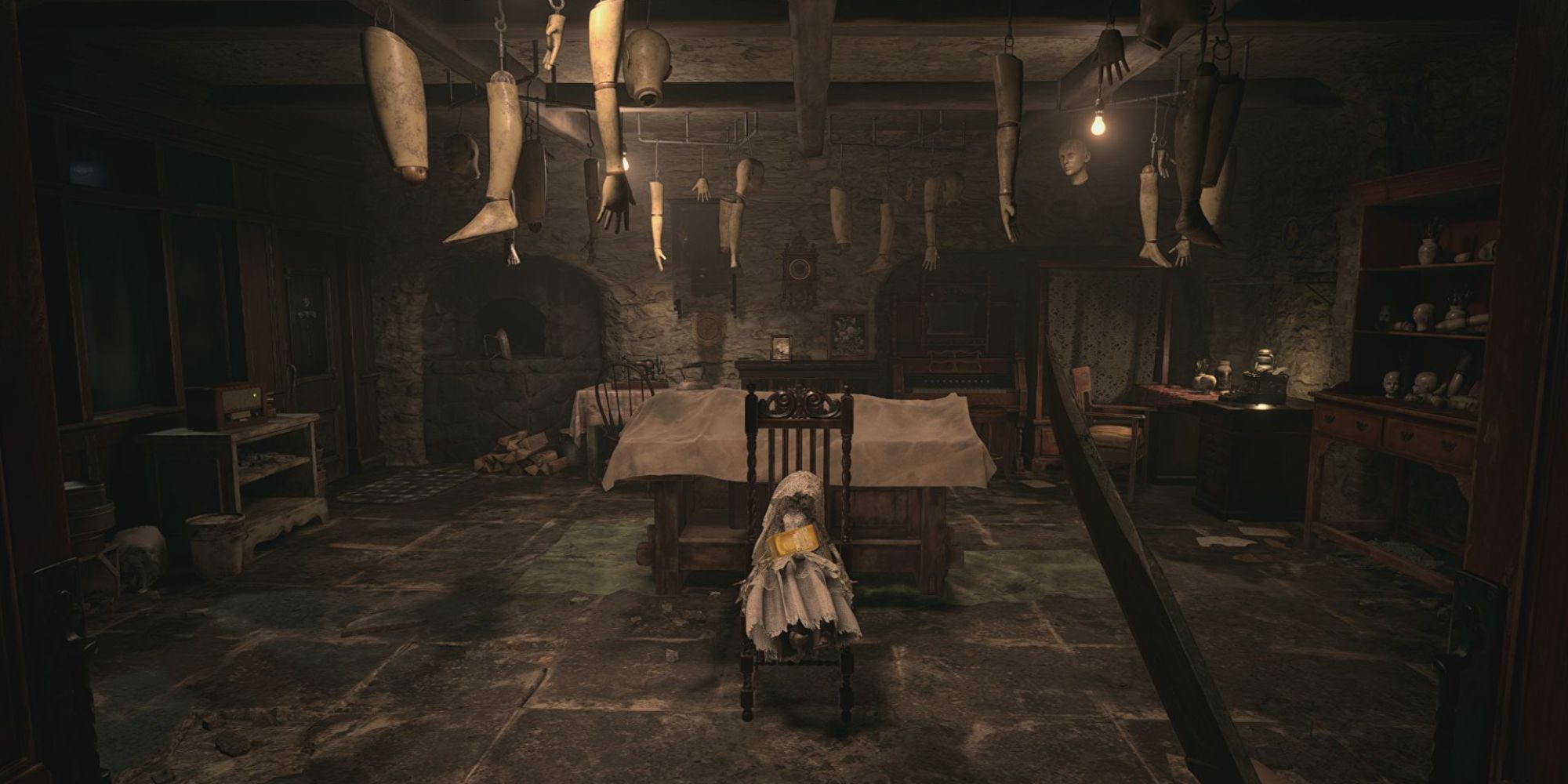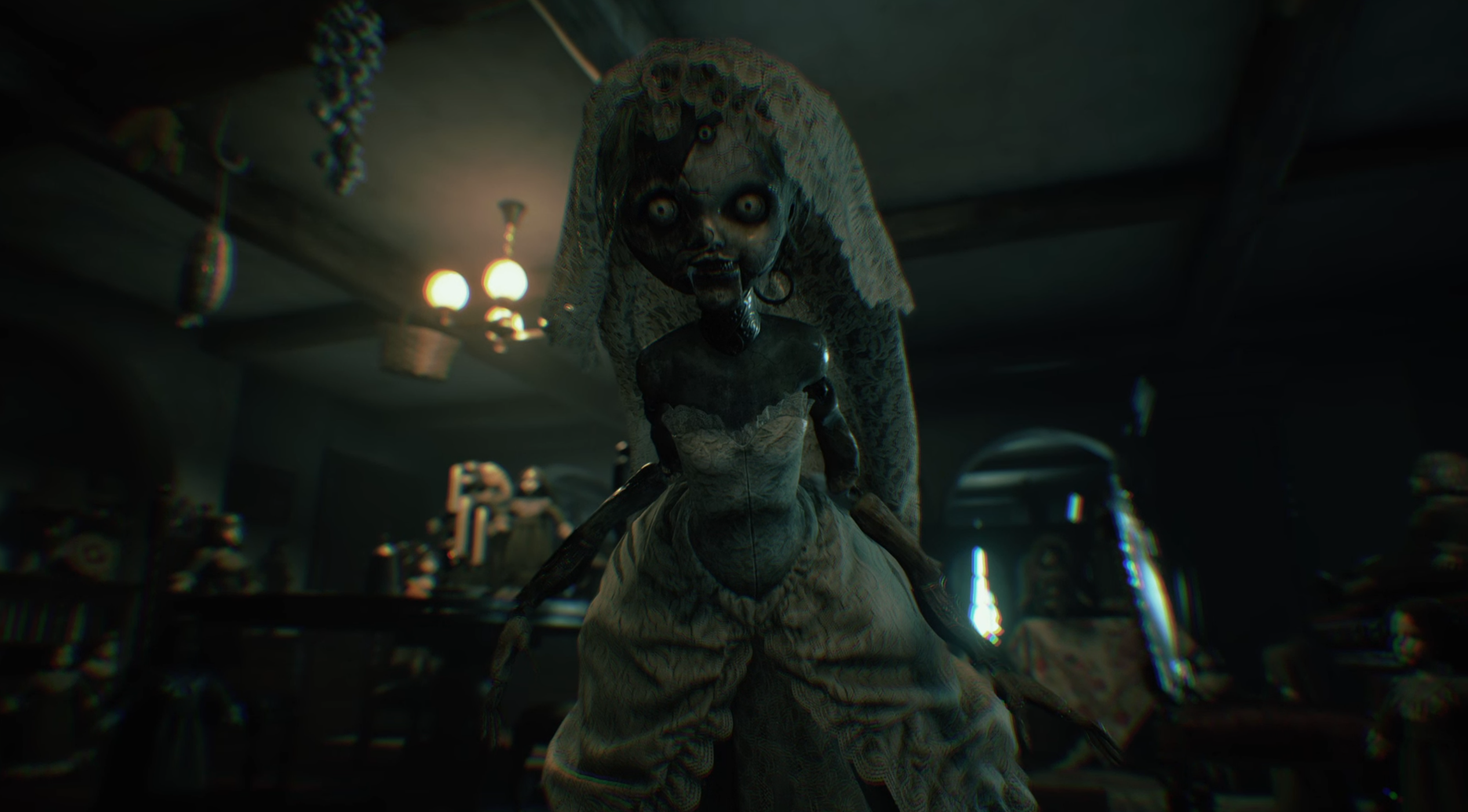What makes Resident Evil Village’s House Beneviento such a memorable sequence? It’s not the monster fetus that chases you around, though you’d be forgiven if that’s the first thing that popped into your mind. The baby is terrifying, and its cries continue to ring in my subconscious even today, but we’ve seen the same exact unstoppable chaser many times before in Resident Evil. Mr. X, Nemesis, and Lady Dimitrescu are effectively the same monster, and if that’s all this chapter had to offer, it wouldn’t have become such an iconic sequence.
But House Beneviento does something Resident Evil has rarely, if ever, done. It breaks from Village’s run-and-gun action and removes your entire inventory, creating a sense of helplessness that amplifies the tension and fear. No longer running scared, Ethan is forced to confront his trauma in a very physical, intimate way. It’s a brilliant sequence that manages to create a remarkable character moment through the clever combination of unsettling imagery and themes personal to Ethan.
There’s a reason House Beneviento is filled with dolls and mannequins. These facsimiles disturb us because they remind us of life yet they themselves are lifeless. For Ethan, these inanimate bodies represent his dead wife and his quadrisected daughter – the family he’s just lost and the reason he’s putting himself through this hell again. After giving up a photo of his family – the only connection he still maintains to them – Ethan enters the house and descends to the basement where he finds a mannequin of his wife on an autopsy table.
The only way to escape the house is to take the mannequin apart, but Ethan isn’t able to just smash it open to get to keys hidden within. The dissection is careful and intimate. He carefully lifts her limbs and feels his way around for the joints, twisting them slowly and removing them piece by piece. Inside this replica of Mia he finds relics and reminders of their life together – a wedding ring, a photo strip of baby Rose – as well as recording of Mia’s private thoughts.
This is a torturous experience for Ethan. The pain of symbolically dissecting his recently-deceased wife’s body while being confronted with her secrets – things she never even told Ethan she was thinking and feeling – is more painful to him than any of the number of times his hand was severed off. As we continue to explore the house, we are eventually able to piece together who Donna Beneviento was and why she’s doing this to Ethan. She recognizes their connection, as they’ve both lost their families. Her Cadou-twisted mind thinks she can subdue Ethan – and by extension Rose – into becoming her new family. When Ethan ultimately kills Donna, he does so reluctantly. Both of them have been transformed by their grief. Of all the haunted houses in Resident Evil, this is the most personal and affecting one of all.
Shadows of Rose brings us back to House Beneviento as Ethan’s daughter, Rose. On a journey to rid herself of her powers, Rose has entered the consciousness of the Megamycete to search for a purifying crystal that will break her connection with the Mold. At the midpoint in her journey she finds herself in the basement of House Beneviento, removed of her weapons and inventory just as Ethan was.
And just like before, Rose is forced to confront her own trauma. She first finds one of her own diary pages that describes being ostracized by her classmates because she is constantly sweating out a milky white substance that the other kids think is gross. We know the impetus for wanting to remove her powers is her feelings of isolation, and this sequence explores that by forcing Rose to construct dioramas of children bullying her, and eventually, burning her at the stake as a witch.
Rose’s experience with bullying doesn’t have nearly the same weight as Ethan losing his entire family, and the game seems to recognize this because it gets off the point fairly quickly. We then discover the figure putting Rose through this trial is Eveline, Miranda’s previous rejected host for Eva who was the cause of the Baker Family Incident in Resident Evil 7. Like Ethan and Donna, Eveline and Rose also have a connection. Rose is the successful vessel and Eveline is the failed one. She resents Rose and wants her to feel just as abandoned and unwanted as she is. Unlike Ethan, however, this isn’t a connection Rose would be able to make because she doesn’t even know who Eveline is.
This is a problem that permeates through the entirety of Shadows of Rose, but the House Beneviento sequence captures the dissonance perfectly. Rose’s journey is an extended callback to the events we remember from Village, but they’re meaningless to her. She doesn’t know The Duke, or Miranda, or Eveline. She doesn’t have a connection to them the way Ethan did, and thematically the entire story suffers for it.
The big scare sequence in Rose’s House Beneviento chapter is a stalking mannequin that Eveline calls Mother. We understand this creature as a twisted parent figure from Eveline’s mind, but what significance does it have to Rose? The mutated baby Ethan faces represents Ethan’s fear of what his daughter might become, but the mannequin mother doesn’t seem to have anything to do with Rose’s trauma. Shadows of Rose is singularly focused on the relationship between Rose and Ethan that Mia is never even mentioned. We know Rose was taken from Mia and raised by Chris at some point, but this never addressed once throughout Rose’s story. If she has trauma surrounding her mother we don’t know about it, and the mannequin mother doesn’t adequately represent it.
Shadows of Rose is less interested in telling Rose’s story, and more interested in rehashing Village’s story and themes. Copying the original House Beneviento sequence without contextualizing it for Rose cheapens it. This is a shallow victory lap for Village that disrespect the complexity of the original but treating it as just another haunted house, freely swapping themes and characters around like they’re interchangeable playing pieces. House Beneviento was purpose built, but Shadows of Rose treats it like custom map, devoid of meaning until you fill it with creepy mannequins and spooky little girls. It fails to recognize what made this chapter meaningful in the first place, and ends up feeling like a waste of time because of it.
Source: Read Full Article

